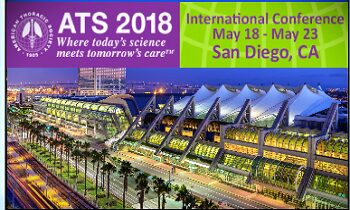Mattek Scientists Attending the ATS 2018 International Conference


Mattek Senior Scientist Dr. Anna Maione and Vice President Dr. Patrick Hayden will be presenting posters at the American Thoracic Society’s 2018 International Conference in San Diego, CA, from May 18 until May 23. Dr. Maione is presenting new research using the EpiAirway and EpiAlveolar tissues to model pulmonary fibrosis and their practical application for studying disease mechanisms and treatment efficacy. Dr. Hayden is presenting new work on the development of an in vitro rat airway model. This is an exciting development in Mattek’s continuing work to bridge the gap between in vivo animals and in vitro human research. Posters can be made available per email request by clicking the link below each poster.
View Our Posters:
Organotypic In Vitro Human Airway Models Can Recapitulate Aspects of Pulmonary Fibrosis
Authors: Anna G. Maione, George R. Jackson, Olivia O’Connell, Jaclyn Foisy, Mitchell Klausner and Patrick J. Hayden
Poster Board Number: P636 | Viewing Time: 11:15-1:00
Session A68 – MOLECULAR DETERMINANTS OF REMODELING IN LUNG FIBROSIS
Thematic Poster Session
Sunday May 20, 2018 9:15 AM – 4:15 PM
Area G (Hall A-B2, Ground Level) – San Diego Convention Center
Introduction: Pulmonary fibrosis (PF) is a debilitating, typically fatal condition that may be caused by a variety of factors, including occupational and environmental exposures, drugs such as amiodarone and bleomycin, radiation exposure, and genetic predisposition. However, in 20-30% of cases the cause is unknown (i.e. idiopathic pulmonary fibrosis, IPF). Currently approved IPF drugs (pirfenidone, nintedanib) have only limited efficacy, and lung transplantation remains the best treatment option for IPF patients. Despite intense research, many of the molecular mechanisms involved in the initiation and progression of IPF remain unknown. Current IPF research relies on animal models and ex vivo lung tissues, which are expensive and are not always predictive of clinical trial results. Currently available in vitro models produced from immortalized cells also do not adequately replicate IPF. The goal of the current work is to develop in vitro organotypic, 3D airway models from primary human cells which can be used to study IPF. Methods: In vitro models composed of differentiated primary human bronchial or alveolar epithelial cells and pulmonary fibroblasts were cultured at the air-liquid interface to replicate the in vivo microenvironment. The tissue models were treated with 10 ng/mL transforming growth factor beta (TGF-β) for at least six days to induce a fibrotic phenotype which was investigated using histological, immunohistochemical and gene expression analyses. Results: Treatment of the models with TGF-β induced changes characteristic of PF, including increased expression of alpha-smooth muscle actin and deposition of Type III collagen and vimentin protein in the stromal compartment. In addition, qRT-PCR revealed increased mRNA expression of other fibrotic markers; matrix metalloproteinase 2, fibronectin and Type III collagen. Conclusions: By recapitulating aspects of PF, these co-culture tissue models provide an experimental system to study the cross-talk between the injured epithelium and fibroblasts, which is believed to be a key factor in PF development. Furthermore, these models can be utilized to investigate the molecular events contributing to pulmonary fibrosis and to evaluate new therapeutic agents.
Comparison of In Vitro Rat and Human Airway Epithelial Models for Inhalation Toxicity Testing
Authors: Patrick J. Hayden, George, R. Jackson, Jr., Anna Maione, and Mitchell Klausner
Poster Board Number: P26 | Viewing Time: 11:15 – 1:00
Session 54- INDOOR AND OUTDOOR AIR POLLUTION
Thematic Poster Session
Sunday May 20, 2018 9:15 AM – 4:15 PM
Area A (Hall A-B2, Ground Level) – San Diego Convention Center
Rationale: Accurate assessment of inhalation toxicity potential is important for developing new therapeutics, evaluating environmental air pollutants and for establishing safe handling, labeling and emergency response procedures for chemicals. Traditionally, animal models have been used for determining inhalation toxicity. However, there is concern that in vivo animal models may not accurately predict human outcomes. Therefore, development of in vitro organotypic airway tissue models constructed from primary human cells has become a high priority in the scientific community. Yet, validation of these systems for predicting in vivo human response is problematic because the available in vivo inhalation toxicity data has been primarily produced using rodents. To address this issue, a scalable in vitro organotypic model of rat mucociliary airway epithelium has been developed to allow the direct comparison of chemical toxicity responses with previously developed in vitro human airway models. Methods: Conducting airways epithelial cells were isolated from CD rats, expanded in culture, and cultured at the air-liquid interface for up to 27 days. A comparison of the toxicity responses in the rat vs. human airway models was conducted using 14 chemicals with in vivo GHS inhalation toxicity classifications ranging from categories 1-5. The airway tissue models were exposed to 4 doses of each test chemical for 3 hrs, followed by measurement of tissue viability. IC75 concentrations for chemical toxicity were determined from the dose-response data. Results: Histological evaluation of the rat and human airway models demonstrated a high level of organotypic mucociliary differentiation including a pseudostratified epithelial structure with copious development of functional cilia. Robust barrier function was demonstrated by development of transepithelial electrical resistance of up to 800 Ω x cm2. Results of chemical toxicity experiments showed that rat and human tissue responses were similar, within the same order of magnitude, for each chemical. Future work will expand the range of chemicals tested to further define the comparative responses. Conclusions: These results suggest that discrepancies observed between in vivo rat and in vitro human toxicity results are likely due to key experimental differences in achieved exposure between the in vivo and in vitro systems, rather than intrinsic differences in toxicity response between rat and human airway epithelia. The in vitro rat airway and human airway models will be useful tools to facilitate rodent to human translation of in vitro inhalation toxicology data, and ultimately a more complete transition to human-based in vitro models of inhalation toxicity.
| Get in touch |

